List of Authors
>>About this blog
Recent blog post
|
[Nojinya]
Nov. 26, 2016 16:00
Hello! What do you think of when you hear "Kiha"? 。 。 。 The person who immediately answered, "It's a diesel car!" 。 。 It's a good answer!
When I hear "Kiha", I remember Jiro Asada's short novel "Poppiya (Shueisha Bunko)".
"When you leave the platform at Miyoro Station, Horomai's single line runs alongside the main line for a while before passing through the streets. The glass-walled resort limited express passes through the Kiha 12-type railcar slowly as if you were looking at it. Whether it's a mischief of the diamond or a production prepared for the urban skier, the train windows of the limited express are bells, watching the vermilion Japan National Railways. 。 。 <Omitted>. 。 。 Kiha 12, which departs at 18:35, is the last of Horomai, which runs only three times a day. "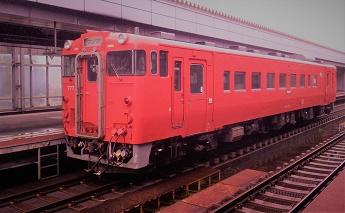
[Nemuro Main Line Kiha 40 bound for Takigawa, which is stopped at Obihiro Station]
"Railroad worker" is a story that develops as the main character of the local line station manager Otomatsu Sato (Ken Takakura), just before the abandoned line in Hokkaido. It was made into a movie in 1999, but at that time, location was being performed at Ikutora Station on the Nemuro Main Line in Minamifurano-cho (Note: Nemuro Main Line was typhoon No. 10 on August 30, this year. It is said that restoration is difficult due to the damage caused by the damage, partly due to the business situation of JR Hokkaido). In commemoration of the movie adaptation, Ikutora Station preserves the top part of Kiha 12, which was modified from Kiha 40. preserves the top part of Kiha 12, which was modified from Kiha 40.
Here is a mini commentary, "Kiha" is a type symbol of JR vehicles. "Ki" refers to a diesel car (railcar) as it is, and "C" refers to an ordinary car, and "Kiha" refers to an ordinary car of a diesel car. Some of the similar ones are "Moha", but "Mo" is a train vehicle (electric vehicle) with a motor and refers to a regular train car. Instead of "c", "c", "shi" or "ne" may enter, but "kilo" is a green car of a diesel car, a dining car if "shi" is entered to a diesel car (railcar) as it is, and "C" refers to an ordinary car, and "Kiha" refers to an ordinary car of a diesel car. Some of the similar ones are "Moha", but "Mo" is a train vehicle (electric vehicle) with a motor and refers to a regular train car. Instead of "c", "c", "shi" or "ne" may enter, but "kilo" is a green car of a diesel car, a dining car if "shi" is entered , and "ne" is a sleeping car . , and "ne" is a sleeping car .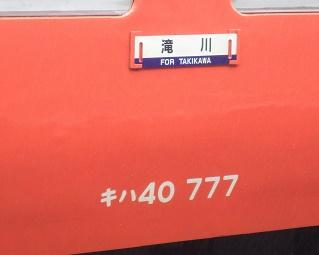
。 。 。 The preface has become longer, but it's time to go to the main subject.
This time, I was a boy who was a railway kid, and a friend with a strong iron told me, "Let's go for drinking !" After work, join at Ningyocho Station and walk for about 5 minutes in the direction of Horidome-cho, where the success Inari is located. Then, in the dark, you will see a common "Noriba" guide at the station. !" After work, join at Ningyocho Station and walk for about 5 minutes in the direction of Horidome-cho, where the success Inari is located. Then, in the dark, you will see a common "Noriba" guide at the station.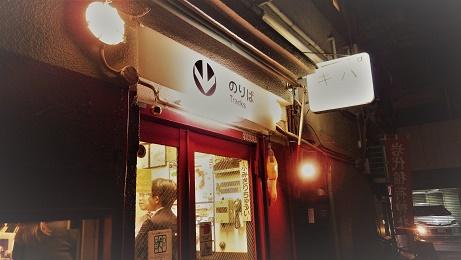
When you open the door unintentionally and enter inside, you will receive a voice of an assistant (master) saying "Thank you for your ride!" There is a yellow information board on the left of the entrance, which is like a subway station yard exit, a transfer to the Hibiya Line, Asakusa Line 2 (although it is actually on the second floor). If you go to the back of the store, you will find a buffet car on the limited express train (Is it a "Kiha" cafeteria car?) A few customers are already enjoying beer  and cooking at the counter like in the above. On the counter, canned food of this store is piled up high, and when ordered by an assistant, it cooks one by one and serves as a snack. First of all, while drinking a toast beer and cooking at the counter like in the above. On the counter, canned food of this store is piled up high, and when ordered by an assistant, it cooks one by one and serves as a snack. First of all, while drinking a toast beer , I decided to have an oil serdin selected by a friend. , I decided to have an oil serdin selected by a friend. 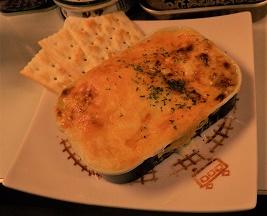 It's quite delicious It's quite delicious because it's stupid with canned food! 。 。 。 And the second cup is a one-cup liquor because it's stupid with canned food! 。 。 。 And the second cup is a one-cup liquor that is indispensable for railway trips. The locally brewed sake Cup in Niigata (Gosen City), where the picture of SL (C57) is drawn! that is indispensable for railway trips. The locally brewed sake Cup in Niigata (Gosen City), where the picture of SL (C57) is drawn! 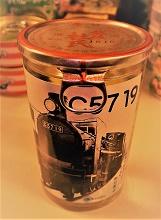 When drinking while saying "It's delicious" with a friend, the customer who was in the back is the manufacturer of the One Cup sake (Kinshihai Sake Brewery) http://www.kinshihai.com/index.html) ) With the president. Today, he was on a business trip to Tokyo, and he stopped by this shop that wholesales sake and also served as a greeting. I feel like traveling with unexpected encounters! When drinking while saying "It's delicious" with a friend, the customer who was in the back is the manufacturer of the One Cup sake (Kinshihai Sake Brewery) http://www.kinshihai.com/index.html) ) With the president. Today, he was on a business trip to Tokyo, and he stopped by this shop that wholesales sake and also served as a greeting. I feel like traveling with unexpected encounters!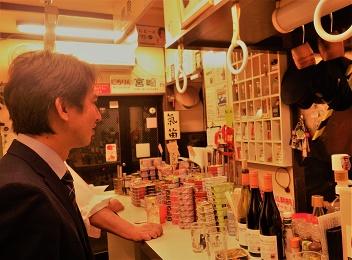
There is a strap that can be grabbed on the counter even if you get drunk, and on the second floor you can sit on a long train seat and drink. It was a standing drink, so I wanted to go in a little bit, but after all, I stayed for about two and a half hours in the delicious food, alcohol, and the fun atmosphere of the shop.
[Kiha, the last station for alcohol and railway lovers]
Location 1-6-11, Nihonbashi-Horidomecho, Chuo-ku, 103-0012, Japan
Phone: 03‐5651‐5088
Business hours From 18:00 to 23:30 (Open on Sundays and holidays, irregular operation (open) on Saturday, so check in advance)
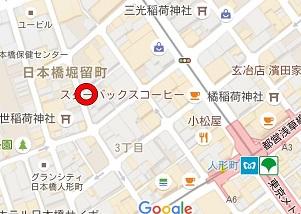
[Nojinya]
Nov. 25, 2016 14:00
Large and long-lasting shaking at dawn (November 22). 。 。 It's been a big earthquake since a long time. Fortunately, there seems to be no direct human damage related to life and death so far, but it was a morning when I was reminded of Japan, a country with many disasters (earthquakes, tsunamis, typhoons, etc.).
For Japan, where the number of foreign tourists is rapidly increasing, it is of course important to introduce content such as history and culture, but also to provide information on disaster preparedness and safety in Japan, especially earthquakes and typhoons. It is also important to give a sufficient explanation of the safety in Japan to inbound tourists who are unfamiliar with disasters, and to have them visit with peace of mind in the future.
It seems that the earthquake has subsided, so when I cross Minami Takahashi near my house for work, the sluice gate from the Kamejima River, which should normally open, to the Sumida River, is closed on a street such as the Nihonbashi Cruise. Is it prepared for the tsunami? (The Japan Meteorological Agency sent tsunami advisory to Uchibo and Izu Islands in Chiba Prefecture at 7:26 am.)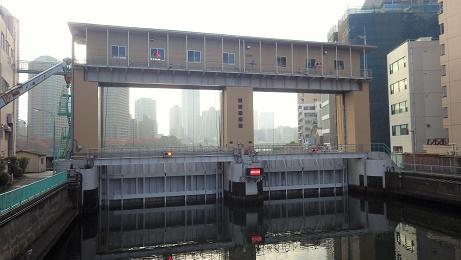
The Kamejima River Sluice Gate is a tide gate created to protect the Kamejima River basin from storm surge damage. The downtown area of Tokyo, which has developed by reclaiming the Hibiya cove since the Edo period, has long been a lot of storm surges and tsunamis. I've been suffering from flood damage. Chuo-ku is also located in areas with relatively low ground heights, and is no exception in this case.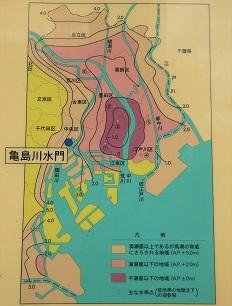
For example, there is a story called "Tsunami" in Seicho Matsumoto's short story book "Mujukujinbetsu Book" (Bunshun Bunko), which was introduced in a blog post I wrote earlier (/archive / 2014/06/post-2075.html), but here, a tsunami depicts a people's footing in Ishikawajima during the Edo period. After the Meiji era, coastal areas such as the Sumida River in the eastern lowland of Tokyo became flooded areas such as floods and storm surges, and storm surge countermeasures were promoted after severe damage such as the Kitty Typhoon (1949) that hit the Kanto area. Will be
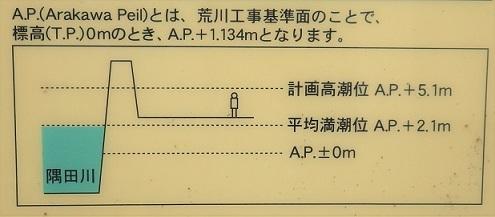
In particular, the storm surge of A.P. + 5.02m in the Nagoya area due to the typhoon in Ise Bay in 1960 (A.P. is "Arakawa Construction Standard Surface". It is determined at the lowest water level of water level station, Reigishi Island in Shinkawa. See the figure above. In the 1960s, the construction of seawalls, the so-called razor dike, began in Tokyo. The Kamejima River Sluice Gate was also completed in 1969 at this time. The gate of the sluice gate is 8.3m, which can prevent storm surges from entering the Kamejima River as well as seawalls. As a result of these measures, when Typhoon No. 20 hit in October 1979, a storm surge (A.P + 3.55m) exceeding the Kitty Typhoon was recorded, but the lives of the local residents were protected without breaching.
It was a Kamejima River sluice gate that I rarely see, but as in this case, when a tsunami or storm surge occurred due to an earthquake or typhoon, etc. and the water level of the river rises, the sluice was closed as soon as possible to prevent flooding and protect the safety of residents and visitors to Chuo-ku. .
[Kamejima River Sluice Gate]
Location 2-31-22 Shinkawa, Chuo-ku, 104-0033, Japan
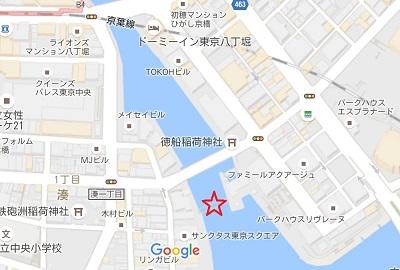
[Nojinya]
Nov. 22, 2016 18:00
On a sunny Sunday, take a walk along the Sumida River Terrace to reach Toyomi Bridge over the Nihonbashi River.
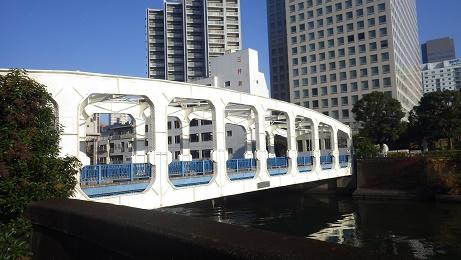
Toyomi Bridge is a place often used for filming dramas and movies due to its design and beauty of the scenery, but in Yue Hiraiwa's novel "Onjuku Kasemi", around Toyomi Bridge where the Nihonbashi River flows into the Okawa (Sumida River), Okawabata (Okawabata)'s basket "Kasasemi" is set on stage. In the Edo period, Eitai Bridge seemed to be a little upstream from the present, over the north side of the Nihonbashi River, and the location of "Kasemi" was just right above the current Eitai-dori St. (around the star mark on the map).
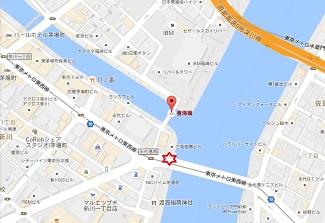
"When I thought that a sharp cold had hit for only three days, it was early spring, when the water of Okawa suddenly became muddy. 。 。 <Omitted>. 。 。 The mansion of his older brother, who served as the scrutiny of magistrate's office Minamicho, was at a time when the gate was standing. From the time I leave the mansion, I'm going to go somewhere in my heart tonight in Okawabata-machi. When Togo Kanbayashi broke up with his friends, he naturally turned his drunk legs there. A little off the side of Toyomi Bridge, "Onjuku, Kasemi" and a small oriental lamp float in the night fog. It's a moist night with no stars or moon."
The first episode of "Onjuku Kasemi" "Early Spring Guest" begins in this way. The drama will be developed mainly by Togo Kanbayashi, the main characters Togo and the master of the Hatago "Kasemi" of Okawabata, who is the younger brother of Minamicho magistrate's office and the professors of Kobusho from the skill of swords, and Rui Shoji, a childhood friend of Togo.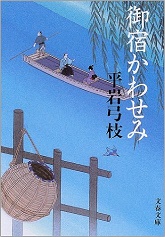
The "Kasemi" series has been serialized in "Novel Sunday Mainichi" in 1973, until the latest work "Ise Sanri" in January 2016 (40 books in Bunko: released from Bunshun Bunko) . In Kasemi, a small incident that occurs in the daily lives of the common people, mainly in the downtown area of Edo, is spoken in a short story, and the appeal is that readers can go back in time to Nihonbashi, Hatchobori, Yagenbori, Shinkawa, and Gunshu in the Edo period together with the same perspective as the person being created.
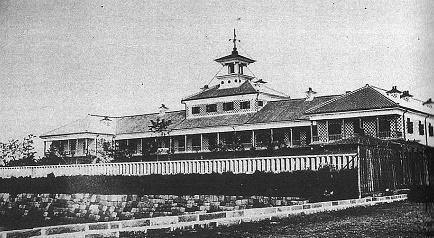 (The photo shows "Edo Hotel (Tsukiji Hotel Building)":* Public domain) (The photo shows "Edo Hotel (Tsukiji Hotel Building)":* Public domain)
The novel continues from the Edo period in the mid-19th century to the Meiji era, but the protagonist is also in his mid-20s to mid-50s, and continues to be talked about by changing generations to his daughter's generation. In the Meiji edition, "Shin Onjuku Kasemi", Tsukiji Reservoir began to appear as a stage, A Rokuban Girls' School (the predecessor of Women's Academy), Edo Hotel (Tsukiji Hotel Building: burned down by Ginza Fire), British Virns and Chen Otori, a tailor of Kiyokuni who has a store in Irifune, will also enrich the international colors.
If you are tired of walking around the city in the daytime, why don't you enjoy the history of Chuo-ku from the Edo period to the Meiji period while reading the "Kasemi" series in autumn night?
[Nojinya]
Nov. 21, 2016 16:00
I often go out of the ward early in the morning on a regular weekend, but today I have no plans and the weather is good, so I decided to walk around the ward after a long absence. From the bus stop in front of Sumitomo Twin Building, go up the slope to Super dike on the Sumida River and walk from Nishizume on Chuo-ohashi Bridge toward Eitai Bridge to enter Shinkawa Park. It's usually time to go to the office, but today it's Sunday, so sometimes jogging or walking dogs go through.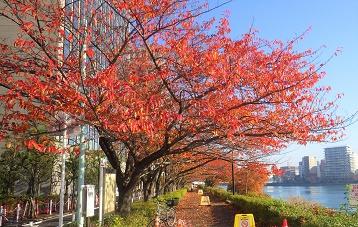
Shinkawa Park is a famous spot for cherry blossoms. Every year from the end of March to the beginning of April, Yoshino cherry tree enjoys beautiful flowers (Blog article on April 7, 2014, "Ohanami Walk from Shinkawa Park to Chuo-ohashi Bridge and Tsukuda Park" /archive/2014/post-1956.html) is quite surprising and surprising. The contrast between the cherry trees that are colored red and the vivid blue of the sky / Sumida River is wonderful.
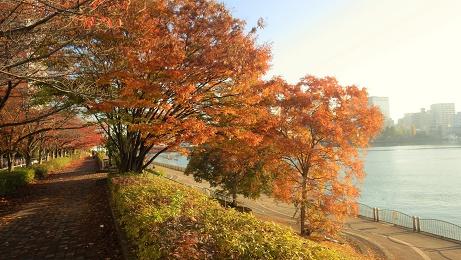
Of course, Shinkawa Park is a tree-lined path, so you can enjoy a walk while watching the cherry blossom maple, which is not a cherry blossom viewing while looking at the top as the spring cherry blossoms. It is beautiful to see the whole cherry tree maple in a distance, but each of the leaves dyed in crimson gives a sense of dignified beauty.
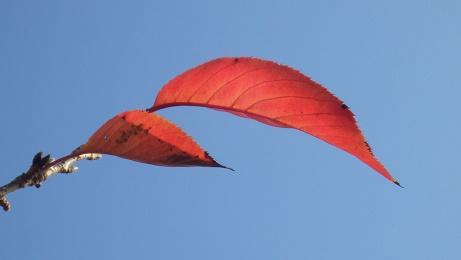
It is said that the cherry blossoms are beautiful because they fall, but the cherry maple also scatters in the blue sky after entertaining our eyes with beautiful red color. It is recommended that you go to see the cherry blossoms at Shinkawa Park, which is now in full bloom, on a sunny day.
[Shinkawa Park]
Location 1-31-32, Shinkawa, Chuo-ku, 104-0033, Japan
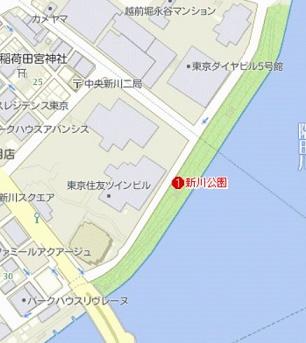
1
|
Links
|

![]() preserves the top part of Kiha 12, which was modified from Kiha 40.
preserves the top part of Kiha 12, which was modified from Kiha 40.![]() to a diesel car (railcar) as it is, and "C" refers to an ordinary car, and "Kiha" refers to an ordinary car of a diesel car. Some of the similar ones are "Moha", but "Mo" is a train vehicle (electric vehicle) with a motor and refers to a regular train car. Instead of "c", "c", "shi" or "ne" may enter, but "kilo" is a green car of a diesel car, a dining car if "shi" is entered
to a diesel car (railcar) as it is, and "C" refers to an ordinary car, and "Kiha" refers to an ordinary car of a diesel car. Some of the similar ones are "Moha", but "Mo" is a train vehicle (electric vehicle) with a motor and refers to a regular train car. Instead of "c", "c", "shi" or "ne" may enter, but "kilo" is a green car of a diesel car, a dining car if "shi" is entered![]() , and "ne" is a sleeping car .
, and "ne" is a sleeping car .
![]() !" After work, join at Ningyocho Station and walk for about 5 minutes in the direction of Horidome-cho, where the success Inari is located. Then, in the dark, you will see a common "Noriba" guide at the station.
!" After work, join at Ningyocho Station and walk for about 5 minutes in the direction of Horidome-cho, where the success Inari is located. Then, in the dark, you will see a common "Noriba" guide at the station.
![]() and cooking at the counter like in the above. On the counter, canned food of this store is piled up high, and when ordered by an assistant, it cooks one by one and serves as a snack. First of all, while drinking a toast beer
and cooking at the counter like in the above. On the counter, canned food of this store is piled up high, and when ordered by an assistant, it cooks one by one and serves as a snack. First of all, while drinking a toast beer![]() , I decided to have an oil serdin selected by a friend.
, I decided to have an oil serdin selected by a friend.  It's quite delicious
It's quite delicious![]() because it's stupid with canned food! 。 。 。 And the second cup is a one-cup liquor
because it's stupid with canned food! 。 。 。 And the second cup is a one-cup liquor![]() that is indispensable for railway trips. The locally brewed sake Cup in Niigata (Gosen City), where the picture of SL (C57) is drawn!
that is indispensable for railway trips. The locally brewed sake Cup in Niigata (Gosen City), where the picture of SL (C57) is drawn!  When drinking while saying "It's delicious" with a friend, the customer who was in the back is the manufacturer of the One Cup sake (Kinshihai Sake Brewery) http://www.kinshihai.com/index.html) ) With the president. Today, he was on a business trip to Tokyo, and he stopped by this shop that wholesales sake and also served as a greeting. I feel like traveling with unexpected encounters!
When drinking while saying "It's delicious" with a friend, the customer who was in the back is the manufacturer of the One Cup sake (Kinshihai Sake Brewery) http://www.kinshihai.com/index.html) ) With the president. Today, he was on a business trip to Tokyo, and he stopped by this shop that wholesales sake and also served as a greeting. I feel like traveling with unexpected encounters!






 (The photo shows "Edo Hotel (Tsukiji Hotel Building)":* Public domain)
(The photo shows "Edo Hotel (Tsukiji Hotel Building)":* Public domain)




